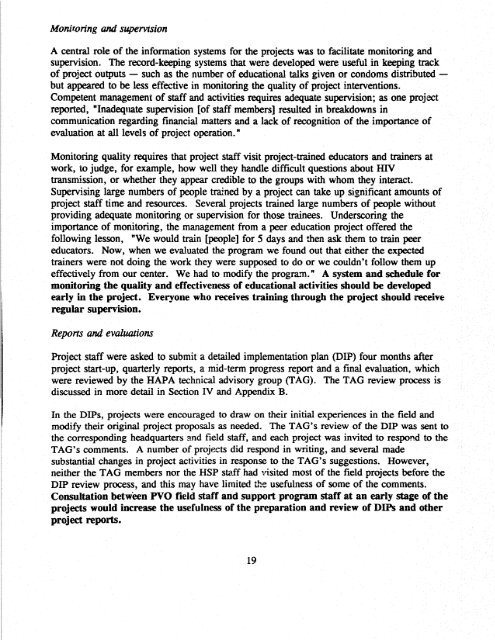The HAPA Support Program - usaid
The HAPA Support Program - usaid
The HAPA Support Program - usaid
Create successful ePaper yourself
Turn your PDF publications into a flip-book with our unique Google optimized e-Paper software.
Monitoring and supervision<br />
A central role of the information systems for the projects was to facilitate monitoring and<br />
supervision. <strong>The</strong> record-keeping systems that were developed were useful in keeping track<br />
of project outputs - such as the number of educational talks given or condoms distributed <br />
but appeared to be less effective in monitoring the quality of project interventions.<br />
Competent management of staff and activities requires adequate supervision; as one project<br />
reported, "Inadequate supervision [of staff members] resulted in breakdowns in<br />
communication regarding financial matters and a lack of recognition of the importance of<br />
evaluation at all levels of project operation. "<br />
Monitoring quality requires that project staff visit project-trained educators and trainers at<br />
work, to judge, for example, how well they handle difficult questions about HN<br />
transmission, or whether they appear credible to the groups with whom they interact.<br />
Supervising large numbers of people tr3ined by a project can take up significant amounts of<br />
project staff time and resources. Several projects trained large numbers of people without<br />
providing adequate monitoring or supervision for those trainees. Underscoring the<br />
importance of monitoring, the management from a peer education project offered the<br />
following lesson, "We would train [people] for 5 days and then ask them to train peer<br />
educators. Now, when we evaluated the program we found out that either the expected<br />
trainers were not doing the work they were supposed to do or we couldn't follow them up<br />
effectively from our center. We had to modify the progra..n." A system and schedule for<br />
monitoring the quality and effectiveness of educational activities should be developed<br />
early in the project. Everyone who receives training through the project should receive<br />
regular supervision.<br />
Repons and evaluations<br />
Project staff were asked to submit a detailed implementation plan (DIP) four months after<br />
project start-up, quarterly reports, a mid-term progress report and a final evaluation, which<br />
were reviewed by the <strong>HAPA</strong> technical advisory group (TAG). <strong>The</strong> TAG review process is<br />
discussed in more detail in Section IV and Appendix B.<br />
In the DIPs, projects were encouraged to draw on their initial experiences in the field and<br />
modify their original project proposals as needed. <strong>The</strong> TAG's review of the DIP was sent to<br />
the corresponding headquarters and field staff, and each project was invited to respond to· the<br />
TAG's comments. A number of projects did respond in writing, and several made<br />
substantial changes in project activities in response to the TAG's suggestions. However,<br />
neither the TAG members nor the HSP staff had visited most of the field projects before the<br />
DIP review process, and this may have limited t'le usefulness of some of the comments.<br />
Consultation between PVO field staff and support program staff at an early stage of the<br />
projects would increase the usefulness of the preparation and review of DIPs and other<br />
project reports.<br />
19

















